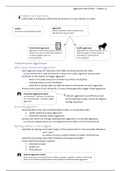Aggression and Conflict – Chapter 13
Robbers Cave Experiment
a field study of intergroup conflict with two groups of 11-year-old boys in a camp
conflict aggression
a perceived incompatibility of goals behavior intended to harm someone else;
defined by the actor’s motive
instrumental aggression hostile aggression
aggression serving mastery needs, used as a aggression that is driven by anger due to
means to an end, to control other people, or insult, disrespect, or other threats to
to obtain valuable resources; self-esteem or social identity;
more systematic more superficial
Interpersonal Aggression
What causes interpersonal aggression?
- when aggression pays off, it becomes more likely (counting rewards and costs)
e.g. for someone who is large and muscular or knows how to fight, aggression becomes easier
- any threat to self-esteem can trigger aggression
− worse if it is public because it is harder to just let an insult go by
− including attacks to one’s worldview
− narcissists or people with very high but insecure self-esteem are more aggressive
- threats to the sense of self, self-worth, or sense of belonging often trigger hostile aggression
frustration-aggression theory
any frustration – defined as the blocking criticism: aggression is set off not so much
of an important goal – inevitably triggers by the blocking of a goal, but by the negative
aggression feelings that result
Increasing aggression
- observing others who react to blocked goals, threats, or provocations with…
1. violent solutions increase aggression
2. nonviolent solutions reduce aggression
- learned cues, which are strongly associated with aggression, can increase aggression
e.g. motorists stopped by police act more aggressively when officer carried a holstered pistol
Deciding whether or not to aggress
- superficial processing: most salient aspect of the environment or most accessible attitude or
norm “wins”
e.g. salience of costs or rewards, behavior of models, situational cues
- systematic processing: when both motivation and capacity available
- factors which limit people’s capacity
1. emotional arousal
2. alcohol use
3. time pressure
General aggression model
theory that person and situation factors influence people’s cognition, emotions, and arousal,
which in turn influence interpretations of the situation and decisions about aggression






